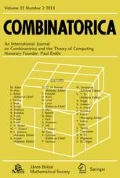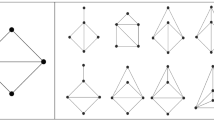Abstract
Given a class ℒ of (so called “forbidden”) graphs, ex (n, ℒ) denotes the maximum number of edges a graphG n of ordern can have without containing subgraphs from ℒ. If ℒ contains bipartite graphs, then ex (n, ℒ)=O(n 2−c) for somec>0, and the above problem is calleddegenerate. One important degenerate extremal problem is the case whenC 2k , a cycle of 2k vertices, is forbidden. According to a theorem of P. Erdős, generalized by A. J. Bondy and M. Simonovits [32, ex (n, {C 2k })=O(n 1+1/k). In this paper we shall generalize this result and investigate some related questions.
Similar content being viewed by others
References
C. Benson, Minimal regular graphs of girth eight and twelve,Canad. J. Math. 18 (1966), 1091–1094.
B. Bollobás,Extremal Graph Theory, Academic Press, (1978) p. XVII.
J. A. Bondy andM. Simonovits, Cycles of even length in graphs,J. Combin. Theory,16 B (1974), 97–105.
W. G. Brown, On graphs that do not contain a Thomsen graph,Canad. Math. Bull. 9 (1966), 281–185.
W. G. Brown, P. Erdős andM. Simonovits, Extremal problems for directed graphs,J. Combin Theory,15/1B (1973), 77–93.
P. Erdős, Some Recent results on extremal problems in graph theory,Theory of Graphs, Intern. Symp. Rome, (1966), 118–123.
P. Erdős, On some new inequalities concerning extremal properties of graphs,Theory of Graphs, Proc. Coll. Tihany (1966), 77–81.
P. Erdős, On sequences of integers no one of which divides the product of two other related problems,Mitt. Forschunginst. Math. u. Mech. Tomsk 2 (1938), 74–82.
P. Erdős, Problems and result in combinatorial analysis,Teorice Combinatorie Proc. Coll. Intern. Roma, settembre 1973.
P. Erdős andA. Rényi, On the evolution of random graphs,Magyar Tud. Akad. Mat. Kut. Int. Kőzl. 5 (1960), 17–61.
P. Erdős, A. Rényi andV. T. Sós, On a problem of graph theory,Studia Sci. Math. Hungar. 1 (1966), 215–235.
P. Erdős andM. Simonovits, A limit theorem in graph theory,Studia Sci. Math. Hungar. 1 (1966), 51–57.
P. Erdős andM. Simonovits, Some extremal problems in graph theory,Coll. Math. Soc. J. Bolyai 4 (1969), 377–390.
Hylten-Cavallius. On a combinatorial problem,Coll. Math. 6 (1958), 59–65.
T. Kővári, T. Sós andP. Turán, On a problem of Zarankiewicz,Coll. Math. 3 (1954), 50–57.
M. Simonovits, A method for solving extremal problems in graph theory,Theory of Graphs Proc. Coll. Tihany, (1966), 279–319.
M. Simonovits, Paul Turán’s influence on graph theory,J. Graph Theory,2 (1977).
R. Singleton, On minimal graphs of maximum even girth,J. Combin. Theory,1 (1966), 306–332.
P. Turán, On an extremal problem in graph theory,Mat. Fiz. Lapok 48 (1941), 436–452
Author information
Authors and Affiliations
Rights and permissions
About this article
Cite this article
Faudree, R.J., Simonovits, M. On a class of degenerate extremal graph problems. Combinatorica 3, 83–93 (1983). https://doi.org/10.1007/BF02579343
Received:
Issue Date:
DOI: https://doi.org/10.1007/BF02579343




